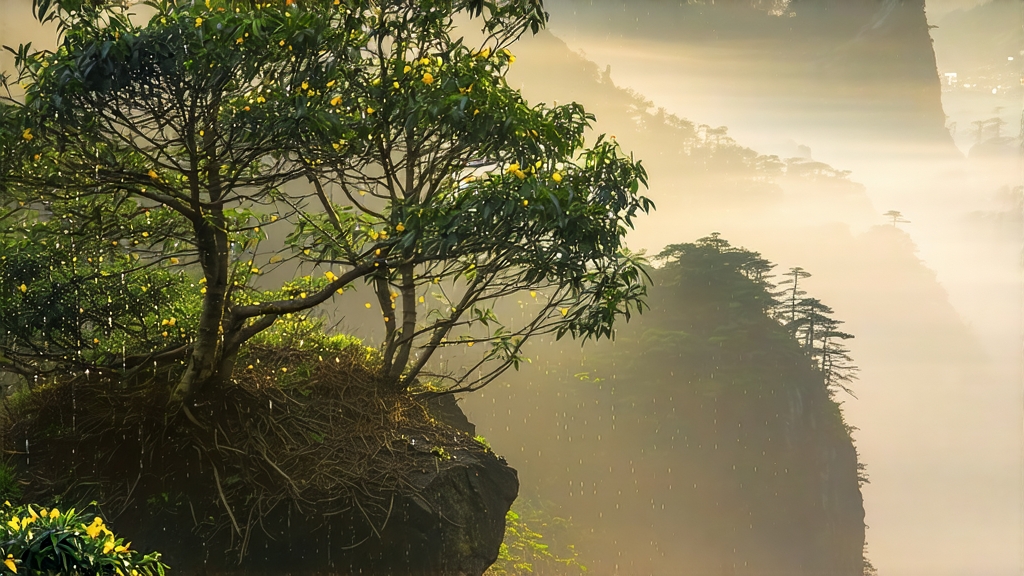
High on the mist-crowned peaks of Mt. Meng in Sichuan province, where clouds brush the shoulders of Tang-dynasty stone terraces, a tea once reserved for emperors still unfurls its velvet buds each early April. Meng Ding Huang Ya—“Mengding Yellow Bud”—is the quietest celebrity of China’s six major tea families. While green teas grab the spotlight and pu-erh fills auction ledgers, this yellow tea has spent thirteen centuries perfecting the art of discretion. To meet it is to step into a chamber of subtle aromas, imperial history, and a craft so labor-intensive that only a few hundred kilograms leave the mountain every spring.
History: from altar of the gods to imperial altar
Legend places the first planting at 53 BCE, when the Daoist monk Wu Lizhen planted seven tea bushes on Meng Ding’s summit as an offering to the “Celestial Master.” By the Tang dynasty (618-907) those bushes had become state property; every picked leaf was carried by fast horse to Chang’an palace along the same courier roads that bore lychees to Yang Guifei. Song emperors codified its tribute status, Ming scholars celebrated it in verse, and Qing merchants weighed it in silver. When yellow tea techniques emerged in the sixteenth century, Meng Ding’s tender buds were the natural candidate for the new “sealed yellowing” process, giving birth to the variety we now call Huang Ya. After 1949 the gardens were collectivized, the craft declined, and for decades the tea survived only in the memories of old monks. A small revival began in the 1980s when retired factory workers re-opened the charcoal-warmed chambers; today fewer than twenty families still master the full traditional protocol.
Micro-terroir: where cloud tongue kisses mineral spine
Mt. Meng rises 1,456 m above the Chengdu plain, punching through the Sichuan fog belt. The difference between day and night temperatures can exceed 15 °C, locking amino acids into every bud. Granitic soils laced with quartz drain rapidly, forcing roots to dive three meters for water, while wild camellias and gingko trees weave a living pesticide net. The critical factor is humidity: 88 % average in April, ideal for the slow enzymatic oxidation that defines yellow tea. Locals say “three clouds a day, one rain every two days,” a rhythm that keeps the buds turgid yet stress-free.
Plucking: the mathematics of exclusivity
Only the single unopened bud, or at most bud-and-half-unfurled-leaf, is taken. Pickers climb 300-year-old stone steps before dawn so that buds are still cool when they reach the village. The standard is 30,000 buds per 500 g of finished tea—roughly one morning’s harvest from a skilled picker. Anything longer than 2 cm is rejected; anything touched by early sun is set aside for green tea. The harvest window spans five days around Qingming festival; a late frost can erase an entire year’s production.
Craft: the secret choreography of men huang
Yellow tea’s soul lies in “sealed yellowing,” a controlled smothering that sits between green tea killing-green and white tea withering. Meng Ding Huang Ya undergoes three iterations:
-
Sha Qing (Kill-green)
Buds are tossed for 4–5 minutes in woks held at 160 °C. The goal is to destroy leaf-surface enzymes while keeping interior biochemistry alive. Masters listen: when the sizzle turns from high-pitched “fry” to low “sigh,” they know the cell walls are breached but chlorophyll is intact. -
Re-wrap Men Huang (Hot wrap)
Within 90 seconds of leaving the wok, the buds are piled 3 cm thick inside linen bags pre-heated to 40 °C. The bags rest inside a bamboo box lined with camellia leaves that donate additional floral precursors. Over 48 hours the pile is turned every four hours; temperature is never allowed above 55 °C. During this sauna the buds suffocate slightly, turning from jade to pale champagne and developing the hallmark “rice-sweet” aroma. -
Low-temperature slow bake
Finally the leaves are laid on horse-hair screens above a charcoal pit fueled by local walnut wood. For three days the fire is kept so low that a hand can rest two seconds on the screen. This desorption removes the last